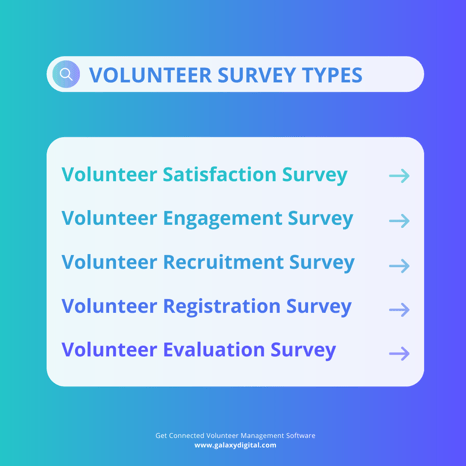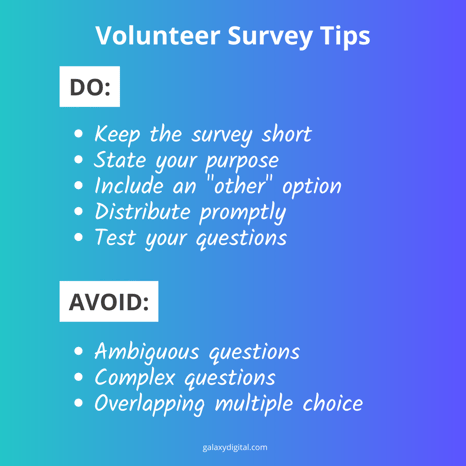Free volunteer survey templates
A volunteer survey is a worthwhile addition to any nonprofit’s toolbox. According to volunteer professionals, surveys are a great way to gather data and analyze your volunteer program, and they tend to lend themselves to relatively high return rates.
In addition to gathering feedback, there are a variety of uses for the volunteer survey. In this guide, we’re answering volunteer professionals’ most commonly asked questions about surveys.
In this article, we’ll recommend volunteer survey tools and best practices, as well as downloadable volunteer survey templates and samples to guide you along the way.
Volunteer Surveys: An Overview
The main aim of conducting a volunteer survey is to gather feedback or information from your volunteers. Most importantly, your organization should conduct volunteer surveys or questionnaires to evaluate current processes and guide future decision-making.
FREE DOWNLOAD
Download Free Volunteer Surveys Performance Evaluation and Volunteer Registration Templates to start collecting important information on your volunteers.
What Is a Volunteer Survey?
A volunteer survey is a series of questions presented to your volunteers to obtain statistically useful answers or feedback.
Some surveys or volunteer questionnaires are used by volunteer coordinators to simply gather the information needed to contact volunteers and schedule them, like volunteer contact information, availability, and interests.
You can also use surveys to analyze volunteer attitudes toward your programs to identify potential areas of improvement.
You may choose to collect some of the following information from your volunteers, depending on your organization’s needs:
- Contact information
- Demographic data
- Availability and scheduling
- Skills and interests
- Experience feedback
- Market research (such as volunteer attitudes and motivation)
From volunteer surveys to hours tracking, volunteer software tools can help you collect important data about your program. Learn more
Volunteer Surveys: The Benefits
When used effectively, volunteer surveys can help your organization improve programming, direct recruitment efforts, and develop substantial qualitative reports.
Collecting volunteer feedback is one of the best ways to empower your volunteers, improve their volunteering experience, and bolster volunteer retention. It’s safe to say that gathering volunteer feedback is a key part of the volunteer management process.
The Impact of Volunteer Surveys
Before you create your survey, think about the goal or purpose of the survey. What are you hoping to achieve by collecting information from your volunteers? Do you want to improve volunteer well-being? Reduce volunteer turnover? Direct administrative processes?
By gathering the right feedback and data from program participants, you can take informed actions to direct your program and achieve outcomes like these:
Improve or Increase:
- Volunteer Training and Orientation Effectiveness
- Volunteer Well-Being
- Employee Well-Being
- Service Recipient Well-Being
- Volunteer Engagement
- Marketing Cost Effectiveness
- Volunteer Program Return on Investment
- Impact Measurement & Reporting
- Grants and Funding
Reduce:
- Volunteer Turnover
- Program Costs
- Recruitment Costs
Direct:
- Program Initiatives
- Marketing and Communication Efforts
- Administrative Processes
To achieve these outcomes, your organization will need to ask insightful volunteer questions based on your goals, distribute them effectively, and report results efficiently.
Let’s start by answering some of the most critical questions nonprofit professionals ask about volunteer surveys.
How to Create a Volunteer Survey
There are a lot of questions that go into making and conducting a successful volunteer survey. Here are the most frequent questions we hear along with our top tips to make the creation and distribution of feedback gathering simpler and more effective:
Top Tools for Volunteer Surveys
There are many online surveys and polling tools you can use. Online surveys are simpler to distribute and collect and tend to lead to quicker response times.
Free online survey tools like Google Forms or SurveyMonkey can offer volunteer form templates and consolidate results in an easy-to-read report. Simply share the survey using the recipient’s email address.
Some volunteer management software systems have integrated volunteer survey templates and question tools to enable coordinators to capture the information they need when a volunteer registers with your site, signs up for a shift, or logs hours.
Get free volunteer survey templates
Integrated tools are convenient; they capture data with the same system you use for your other management processes and store results in a centralized database.
Whichever way you choose to create your survey, we recommend you do so online with a secure platform.
Learn more about the #1 volunteer management software - Get Connected >>
Distributing Your Volunteer Survey
We find that the best way to conduct your volunteer questionnaire or survey is online, either through email or your volunteer management platform. However, bear in mind that some of your volunteers may not have internet access or email addresses.
So, consider having a paper version handy. Here are the top ways to distribute a volunteer survey:
Online Platform
You may already use volunteer management software where volunteers register for opportunities, submit their information, and log hours. Some volunteer management platforms have an integrated survey tool, making it easy to collect data from volunteers when you need it.
You can distribute the survey by emailing your volunteers. If you created the survey online, you can copy and paste the link in the email body or attach a PDF copy. Online survey tools will allow you to collect survey responses anonymously, which can yield more accurate results.
Pro tip: Some volunteer management platforms have built-in Email Messaging capabilities to help automate these emails.
.gif?width=1248&height=720&name=Feature%20Page%20Assets%20(2).gif)
Mail
Some of your volunteers may not have regular access to the internet. In this case, consider mailing a paper survey. Give respondents clear instructions on how and when to submit their survey responses.
Include a pre-addressed and stamped return envelope to reduce barriers and increase response numbers.
In-Person
Sometimes, you may want to ask volunteers to fill out your survey in person. For example, following a training session or event, you can ask volunteers to fill out your survey before they leave, and while the information is still fresh in their heads.
Keep in-person surveys brief. Remember, they’re already volunteering their time.
Whichever distribution method you choose, be sure to communicate the deadline (the date by which you want respondents to submit their responses) and clear instructions about how to submit their survey. If you want the survey to be submitted anonymously, make sure to include this in the instructions.
Want free resources to help you write your own volunteer survey questions? Download Now
Determining Volunteer Sample SizeIf you’re surveying for research or reporting, you’ll need to determine the sample size required to get an accurate picture of the data you’re trying to collect.
The sample size is the number of completed surveys you should strive to analyze. The simplest way to determine is by using an online sample size calculator.
There are several free options available with a quick internet search. You will need to input the following information into the calculator:
Population Size
Population size refers to the number of total volunteers in your program.
Confidence Level
The confidence level is expressed in a percentage. The recommended standard is 95%. If the sample size were surveyed repeatedly, the results would match those of the actual population polled 95% of the time.
A 100% confidence level means there is no doubt that the sample size results would match the total population results every time. A 100% confidence level doesn’t exist in statistics. However, it helps visualize what we mean by the confidence level.
If you’re still unsure, stick with industry-standard (95%) when calculating sample size.
Margin of Error
The margin of error in statistics accounts for the percentage of random sampling error in a survey’s results.
The greater the margin of error, the less confidence someone should have that the surveyed sample would represent the “true” results. A +/- 5% margin of error is a standard entry for your volunteer survey.
These three values will give you your sample size. For example:
Let’s say, using the industry standard for confidence level and margin of error, your program has 2,000 total registered volunteers. Per the sample size calculation, you will need to collect surveys from 323 volunteers to get results you can trust.
How to Get Volunteers to Participate
Here are a few volunteer incentive ideas to boost response rates:
Clarify the Benefits
While most of your volunteers just want to help you out, let them know how they can benefit from taking the time to fill out your survey.
Will it help your organization improve the volunteer experience? Will you be able to better match them with an opportunity they’ll love?
Include this brief but punchy text in a letter, in an email, or as an introduction to the survey.
Make it Anonymous
Volunteers may shy away from taking your survey if they put their names on the survey or return the survey via personal email.
If you’re worried about receiving honest and constructive feedback, make your surveys and forms anonymous. Likewise, if you’re sharing survey results with the public, inform your volunteers.
Communicate the Purpose
Why do you need volunteers to complete the survey? What is your organization hoping to glean from the results?
Be transparent about your organization’s goal, and volunteers are more likely to understand that their feedback has real implications for your organization. Again, communicate your goals in an introduction to the survey.
Offer a Small Incentive
A raffle ticket for a prize drawing or a small gift card to Starbucks can be enough to encourage volunteers to take your survey.
Build Hype on Social Media
Announce your survey on social media or your website and include a link to the survey location. Make your post engaging and have a call to action.
Here’s a fun example:
“Calling all community superheroes! It’s time for our Annual Volunteer Impact Survey, and we need you, our trusty volunteers! Click here to share your voice.”
Pro tip: Use Social Media Integrations to share opportunities, events, and community announcements straight from your volunteer platform.
Learn more about Social Media Integrations
Send a Few Friendly Reminders
Your volunteers are busy, and may just need a reminder or two to complete your survey. We find that a friendly, gentle email does the trick. Don’t bombard their inboxes, however, or you’ll just annoy your volunteers.
Volunteer Survey Questions
Use this table of the most common volunteer survey topics to choose the one that best matches your organization’s goals.
This table is followed by a breakdown of the most commonly used questionnaires and forms, with nonprofit volunteer survey samples.
| Management Category | Primary Goal | Action | Type of Survey to Conduct | When to Administer |
| Volunteer Retention | Understand why your volunteers want to participate with your organization and what may cause them to leave. | Use volunteer feedback to analyze and guide volunteer retention efforts. | Volunteer Satisfaction Survey | Within 24 hours of volunteer participation |
| Volunteer Engagement | Understand the motivations of volunteers to better engage them. | Use qualitative feedback to analyze and direct engagement efforts. | Volunteer Engagement Survey | Annually |
| Volunteer Recruitment | Understand what drives volunteers to sign up and how they found your organization. | Use feedback to recruit more volunteers and guide marketing strategy to prospective volunteers. | Volunteer Recruitment Survey | During volunteer registration or onboarding |
| Volunteer Placement | Understand the interests and specialized skills of each volunteer. | Match volunteers to the right opportunities based on their skills and interests. | Volunteer Skills and Interests Survey | During registration or onboarding |
| Volunteer Impact Reporting | Understand how volunteer work makes an impact, from the volunteer point of view. | Report impact based on volunteers’ perceptions and experiences. | Volunteer Impact Survey | Quarterly or Prior to end of funding cycle |
| Volunteer Performance | Understand how our organization can better train and prepare volunteers. | Perform volunteer evaluations based on their performance and preparedness for their work. | Volunteer Evaluation Form | Annually |
Note that this table only offers suggestions, and you’re not limited to these volunteer survey examples.

Once you decide which survey is right for your use case, you can use the guide and the nonprofit volunteer survey samples below to formulate the right volunteer survey questions.
Volunteer Satisfaction Survey
A volunteer satisfaction survey is standard among volunteer coordinators. Use this type of survey to understand whether your organization and its practices meet your volunteers’ expectations.
Volunteer professionals can use the volunteer satisfaction survey if they are concerned about retention rates or if they want to report on the volunteer experience to community members, the board, or donors.
Below, we’ve compiled some sample volunteer retention survey questions to help report on volunteer satisfaction.
Volunteer Satisfaction Survey Questions
- How would you rate your overall experience? 5 = positive experience, 1 = negative experience.
- How satisfied did you feel after volunteering? Very Satisfied, Satisfied, Neutral, Unsatisfied, Very Unsatisfied
- How likely are you to recommend our volunteer opportunities to friends, coworkers, or family? Very Likely, Likely, Unsure, Unlikely, Very Unlikely
- How many hours of training did you receive for your assigned volunteer role? None, 1-3 hours, 4-6 hours, 7+ hours
- Please rate the training you received. Very Helpful, Helpful, Neutral, Unhelpful, Very Unhelpful
- How valued did you feel as a member of our organization? Very Valued, Valued, Neutral, Undervalued, Very Undervalued
- How likely are you to volunteer with us again? Very Likely, Likely, Unsure, Unlikely, Very Unlikely
Questions that use metrics (like the ones above) to rate experiences are especially useful for quantifying and visualizing results. They provide a snapshot of volunteer satisfaction while yielding enough detail to make more substantial claims than questions with “Yes or No” answers.
This type of questionnaire is quick to fill out, so you can administer more frequently than open-ended surveys. That’s not to say you can’t add a few short open-response questions to get a better sense of volunteer sentiment.
Open-ended questions like these are appropriate for gauging volunteer satisfaction:
- What do you enjoy about volunteering with us?
- Did you receive recognition or non-financial benefits when volunteering with us? If so, what did you receive?
- What would you say is the main reason you volunteered with us?
The best volunteer surveys are a concise mix of questions like matrix, multiple-choice, and open-ended. When compiling your volunteer satisfaction survey, make sure every question is focused and reflects the survey’s purpose.
It can be tempting to want to get all the answers from your volunteers in one mega-survey. However, you’re much less likely to get honest responses (or any responses at all) if you’re asking your volunteers to fill out a 20-page questionnaire.
So, how long should your survey be? Generally, surveys should take less than 7 to 8 minutes to complete (abandonment rates increase after 8 minutes). That’s an average of 3 to 10 questions, depending on the type of answers you’re asking volunteers to provide.
Bear in mind that you will need to gather enough data from your volunteers for the survey to be effective. Striking a balance between too few and too many questions is key to collecting insightful data from your volunteers.
Volunteer Engagement Survey
Learn why your volunteers do the work they do. Some of the questions may overlap with your satisfaction survey, but here you’re asking volunteer motivation questions that get at the deeper reasons your supporters stay engaged with your cause.
This survey can also help your organization learn about the issues that are most important to your community.
Volunteer Engagement Survey Questions
- Do you feel your volunteer work is significant or impactful? If you answered no, please explain the factors that may make your volunteer work more meaningful.
- Do you feel comfortable sharing your input or suggestions with us? If you shared your suggestions and feedback before, how were they received?
- Do you feel like a valued member of our organization? What is something that we could do to make you feel valued?
- What do you think is the most important work you do for the community through our organization?
- What do you think is the most important work you do to support paid staff?
- Have you identified a need in our community that you think our organization could address? Please explain.
- In what ways can our organization be more supportive of your work as a volunteer?
- What motivates you to volunteer?
- Do you feel that you received enough training and information to feel prepared and carry out your volunteer work as effectively as possible?
- Do you feel your efforts had noticeable results? Were these results communicated to you?
Free volunteer survey question PDF - Download Now
When analyzing the answers to open-ended questions like these, bear in mind that the answers will yield qualitative results. While quantitative results are numerical, qualitative is anecdotal. A quantitative result may read, “50% of volunteers felt their training was valuable.”
On the other hand, qualitative results require a bit more analysis but will invite volunteers to share their thoughts and stories. These probing questions should help you to understand what motivates your volunteers, how they perceive the effectiveness of the work they do, and how your organization can support their work.
It may feel overwhelming to consolidate data that isn’t merely numerical. Start by looking for patterns and the most pressing results based on your volunteer answers.
For example, did a portion of your volunteers report feeling undervalued? Focus your attention on one group of answers, and compile a list of the specific reasons why volunteers did not feel valued.
Only after you have a definite sense of why volunteers reported these answers will you develop real solutions.
This report from the University of Notre Dame outlines key volunteer motivations that can help you formulate probing questions and support your volunteer engagement research.
Volunteer Recruitment Survey
This volunteer survey aims to zero in on the reasons and means by which new volunteers sign up with your organization. You can use this information to direct resources toward your recruitment and marketing efforts.
Here are some useful sample questions to get the most out of your survey:
Volunteer Recruitment Survey Questions
- How did you hear about our organization? Newspaper, Email, Ad, Online, Coworker, Family or Friend, Social Media, Other (Please specify).
- What compelled you to volunteer with our organization?
- By which means did you register with our organization?
- Please specify the volunteer work or role for which you registered. If you have not registered with an opportunity yet, please specify.
- Were you provided with a clear position description?
- Please rate the ease of locating and signing up for a volunteer opportunity. Very easy, easy, neutral, difficult, very difficult
- How soon were you contacted after registering with our organization?
- How were you contacted? Phone, Email, Letter
- If you received assistance from staff, how would you rate your experience? Very helpful, Helpful, Neutral, Unhelpful, Very Unhelpful
- Is there anything we can do to improve your registration experience?
The recruitment survey can serve as a brief addendum to your volunteer follow-up or registration form to consolidate onboarding documents and simplify volunteer registration.
Volunteer Registration Form
This survey or form is practical in purpose and is simply used to gather the information required to coordinate and schedule volunteers. Here are some sample volunteer form questions to consider:
Please enter the following information:
- Last Name, First Name
- Primary Phone Number
- Email Address
- Zip Code
- What is your availability? Please circle the days that work for you, and specify morning, afternoon, or evening.
- Do you have any specialized skills that you think would be well-suited to the program?
Keep reading for a free download of our sample volunteer sign-up sheet, including volunteer scheduling and volunteer interest questions!
And remember, if you have volunteer management software, you can easily capture volunteer contact details, signed waivers and qualifications, interests and skills, and any other custom information in one, centralized process.
Volunteer Evaluation Survey
Remember that volunteers donate their free time to your organization, so volunteer coordinators should appropriately administer volunteer evaluations.
However, your organization may be required to administer volunteer evaluations for employee volunteer grants, students participating in service learning, and court-mandated volunteers.
Or you may also ask a sample of your volunteers to participate in a volunteer evaluation survey to improve your volunteer program processes.
Free sample volunteer sign-up sheet and volunteer evaluation template for Excel - Download Now
Volunteer Survey Tips and Best Practices
Follow these survey best practices to get the most out of your results:

Keep Your Survey Succinct
Shorter surveys tend to yield higher response rates. Therefore, your volunteer survey should only take a few minutes to complete (around 10-12 questions).
Limit open-ended questions If you’re conducting a more detailed survey and need to make it longer, we recommend including progress bars (if available) so volunteers can save their answers as they go along.
State the Purpose of the Survey
At the top or beginning of each survey, clarify the purpose precisely. What is your organization hoping to learn? From whom are you hoping to retain this information?
Avoid Ambiguous Questions
Your volunteers should know what you’re asking, especially if you’re asking open-ended questions like, “How do you feel about the work you do?” This example is vague and may lead to confusion on both ends. Instead, add enough context to direct your volunteers’ answers.
Instead, try questions like:
“Do you feel like the volunteer work you do is important to the community?”
“Do you feel like a valuable member of our organization? Please briefly explain why or why not.”
“What do you feel is your most important contribution to the community?”
Don't Cram Too Much Into One Question
Questions with many parts can make volunteer answers challenging to analyze. Instead, isolate each item so that volunteers can provide a single brief answer for each question you’re asking.
Avoid Leading Questions
The goal of your survey is to extract truthful responses. Leading questions can influence participant answers.
So, avoid questions like, “Are there any areas of improvement you’d like to see in training, such as the length of training?”
Instead, try questions like, “Are there any ways you think this organization can improve training? If so, please explain.”
Avoid Overlapping Numbers in Multiple-Choice Options
You want your numerical data to be as precise as possible.
Avoid: “How many hours did you volunteer this month? Select 0-10, 10-20, 20-40.”
Instead: “How many hours did you volunteer this month? Select 0-10, 11-20, 21-40.”
Include the “Other” Option
You don’t want to force your volunteers to choose an answer that doesn’t apply to them. Provide multiple-choice answers that include an “other” option and a blank space for survey participants to fill in their responses.
Distribute Promptly
Distribute volunteer questionnaire forms and surveys between 24 hours and 48 hours after an event, onboarding, or training while the experience is still fresh.
Test Your Questions
Do your volunteers understand what you’re asking? Are you getting the answers you need? Test your questions with a small focus group of volunteers or staff before distributing them to the entire sample.
Volunteer Feedback Results: What To Do Next?
Your surveys should have real implications. Volunteers took the time to share their feedback; now, you can use this information for good!
The goal of every survey you conduct is to collect information that informs actions your organization will take, and all efforts should focus on furthering your organization’s mission.
Look for Consistencies
While every participant’s feedback is essential, you may not be able to put every suggestion from your volunteers into action. Instead, start by identifying the recurring, major themes, problems, and successes.
Some online survey tools or volunteer management software will store and tally results for you.
To ensure your survey is accurate, gather enough survey results (based on the calculated sample size above) before analyzing and compiling answers.
Compile Your Results
Decide on the information you want to share with your audience. You may be wary of distributing negative feedback, but sharing constructive data can demonstrate transparency and trust among stakeholders.
Remember that personal volunteer information should remain confidential and anonymous. When compiling your data, you can include quantitative (expressed in percentages and sums) and qualitative data (expressed in quotes, summaries, and case studies).
You may also include visuals like charts and graphs and infographics to add interest to your report.
Make volunteer management easy!
Keep track of volunteer time, post available shifts, and allow new volunteers to sign waivers with Get Connected volunteer software.
 Just looking for an easy volunteer sign-up tool you can start using FREE and set up in 5 minutes? Try Shift instead
Just looking for an easy volunteer sign-up tool you can start using FREE and set up in 5 minutes? Try Shift instead
Share Your Results
With whom should you share your results? Your board, staff, volunteers, or community stakeholders. Some organizations choose to publish annual survey results in a formal report, especially for the use of board members, funders, and other stakeholders.
Also, organizations can share exciting survey results on social media or as a feature in their monthly volunteer newsletter.
Gathering your volunteers’ feedback is an essential practice for nonprofits to improve programs, build loyalty, and increase volunteer retention. We encourage you to make the most of your next volunteer survey.






